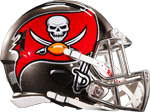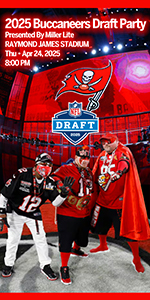
Ownership History of the 27th NFL Franchise
APRIL 24, 1974 Tampa Bay is awarded the league’s 27th franchise. On October, 30th, 1974, Philadelphia construction executive Tom McCloskey is awarded the new Tampa Bay franchise, but soon declines ownership.
Thomas D. McCloskey
May 27, 1924 — October 31, 2004: McCloskey was a Philadelphia construction magnate. He became the president of McCloskey & Company, Builders, in 1961 when his father, former Democratic National Treasurer Matthew H. McCloskey, was appointed U.S. Ambassador to Ireland.
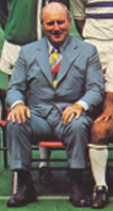
McCloskey grew up in the Overbrook section of Philadelphia, where he attended prep school and participated in football and swimming. He attended the University of Pennsylvania and then served in the United States Marine Corps during World War II. He supervised the building of, among others, the Philadelphia Mint, Centre Square, the Mann Music Center, Veterans Stadium, The Spectrum, and RFK Stadium.
He was chair of the Liberty Bowl, shortly before it left Philadelphia. McCloskey was the founder of the Philadelphia Atoms of the North American Soccer League; the team played in McCloskey's Veterans Stadium. After failing in a bid to purchase the NFL's Philadelphia Eagles, he was granted the Tampa Bay Buccaneers expansion franchise. He could not come to terms with the NFL over a payment method, and was replaced as owner by Hugh Culverhouse before the team began play.
McCloskey died at of cancer in 2004 at a West Palm Beach hospital. He was survived by a wife, an ex-wife, two sons and two daughters.
Hugh Franklin Culverhouse, Sr.
February 20, 1919 – August 26, 1994: Culverhouse was the longtime owner of the Tampa Bay Buccaneers from opening season. He was a successful tax lawyer, and his real estate investments made him one of the nation's wealthiest men. His work brought him into contact with National Football League team owners, and his failed purchase of the Los Angeles Rams placed him in line to become the owner of the fledgling Buccaneer franchise. He owned the team from its inception until his death.
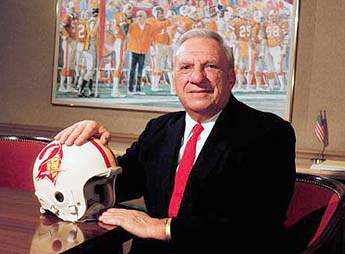
He became one of the most influential team owners in the NFL, and was credited with modernizing the league, even while his teams were rarely competitive on the field. He oversaw the league's course of direction through two player strikes, and the modern league's financial stability is in great part due to his leadership. He held influence for over a decade, before stepping back due to criticism of what other owners saw as his overly-secretive ways.
Culverhouse was initially lauded for bringing professional football to the Tampa Bay area, but eventually came to be blamed for the team's struggles. His refusal to pay Doug Williams at a salary level comparable to that of the league's top quarterbacks insulted fans, and was seen as the beginning of the team's decline during the 1980s. It further led to the belief that Culverhouse was unconcerned with fielding a winning team, as long as it was financially profitable. The Buccaneers' NFL-record streak of fourteen consecutive losing seasons cemented this perception, although Culverhouse did make several notable attempts to improve the team.
Culverhouse was diagnosed with cancer in 1992, and died in 1994. His apparent attempt to exclude his wife from his inheritance led to posthumous revelations of extramarital affairs. Ensuing lawsuits caused an ownership crisis that almost required the team to relocate to another city, before the Glazer family stepped forward with a purchase offer.
Early Life
A native of Birmingham, Alabama, Culverhouse attended the University of Alabama, where he was a member of Delta Kappa Epsilon fraternity (Psi chapter). On the University of Alabama boxing team, he competed together with future governor George Wallace, an experience to which he attributed his confidence in later life. He graduated in 1941. After serving in the Army Air Corps in World War II, he earned a law degree from his alma mater in 1947. He immediately took a job as an assistant state attorney general, serving there for two years. After serving in the Korean War, he became legal counsel for the Internal Revenue Service, where he prosecuted many of the cases resulting from the organized crime investigations of Senator Estes Kefauver. He resigned from the IRS in 1962 after a decade of service, and moved to Jacksonville, Florida, where he entered private practice, specializing in tax law. Although he was considered to be one of the nation's top tax lawyers, one whose cases were sometimes cited by the Supreme Court of the United States, his fortune was built on real estate investments. Listed by Forbes magazine as one of the 250 wealthiest people in the United States, he eventually had investments in 37 companies and was worth over $380 million at his death. He served as a personal representative of President Gerald Ford, bearing the title of U.S. Ambassador, at the 1976 Winter Olympics in Innsbruck, Austria. The University of Alabama's Culverhouse College of Commerce and Business Administration is named for him.
Culverhouse's investments included several banks, Provincetown-Boston Airlines, the Palmer Ranch real estate development near Sarasota, Florida, and movie productions including A Chorus Line and The Emerald Forest. He was criticized over a planned extension of Interstate 75 into South Florida, as its route went directly past land owned by numerous powerful investors, including Culverhouse, Governor Bob Graham, State Attorney General Jim Smith, and the Arvida Corporation.
Ownership of the Tampa Bay Buccaneers
In 1972, Culverhouse had a handshake deal to buy the Los Angeles Rams from owner Dan Reeves for $17 million, only to learn that Reeves later sold the team to Robert Irsay for $19 million. When Irsay then traded teams with Baltimore Colts owner Carroll Rosenbloom, Culverhouse sued, claiming that the others had conspired to prevent his purchase of the team. An out-of-court settlement guaranteed Rosenbloom's aid in getting an expansion franchise for Culverhouse. The opportunity came two years later, when the league expanded to Seattle and Tampa. Culverhouse was offered the Seattle expansion franchise, but declined it due to his residence in Jacksonville. Philadelphia construction company owner Thomas McCloskey was originally awarded the Tampa franchise, but soon found the business arrangement to be different than what he had expected, and backed out of the deal. Culverhouse was then awarded the franchise by the Art Rooney-chaired NFL Expansion Committee, ahead of Fort Lauderdale furniture chain (and future Boston Celtics) owner Harry T. Mangurian, Jr. The name "Tampa Bay Buccaneers" was chosen as a nod to the team representing not only the city of Tampa, but the entire Florida Suncoast area; and to the pirates who once inhabited the area.
Culverhouse quickly became one of the most influential NFL owners; he served as a member of the Player Club Relations Committee that handled player grievances, and of the NFL Congressional Committee. He was a member of the Executive Committee that handled negotiations during the 1982 NFL strike, an experience that earned him great praise from NFL negotiator Jack Donlan. Donlan praised Culverhouse's logic, analytical, and problem-solving skills, and his effectiveness "at getting his way". Culverhouse was credited with having a big hand in the owners' course of direction during the strike, and was responsible for recruiting Donlan as negotiator. He repeated the role during the 1987 players' strike, after which NFLPA President Gene Upshaw described him as "formidable", and said that "at times, the whole league seemed to flow from this one guy". He was chairman of the NFL Finance Committee and the Management Council Executive Committee. His efforts were instrumental in bringing Super Bowl XVIII to Tampa, despite a lack of adequate hotel space in the city. Culverhouse was also a pioneer in using computers to handle team finances and scouting reports. He was a member of the four-man committee that stripped ownership of the New England Patriots from the Sullivan family when their debt became too great. Patriots founder Billy Sullivan later accused Culverhouse of blocking his effort to propose a stock sale that would have eased the debt. Culverhouse distanced himself from the NFL power core in later years, stung by other owners' criticisms of the Management Council. NFL Commissioner Paul Tagliabue credited Culverhouse for building much of the strength and unity of the modern NFL.
General Criticism
Culverhouse was criticized by other team owners as the team prepared for its debut season, who said that his involvement in day-to-day team operations was reminiscent of the owners of the expansion Falcons and Saints, teams which had yet to qualify for the playoffs after a decade of play. Buccaneer employees were described as living in an "atmosphere of fear", especially after the firings during the 1977 offseason of executives who had been involved with unpopular decisions that Culverhouse had supported at the time. In one case, marketing director Bill Marcum was fired due to public backlash over the team's $12 ticket prices for an exhibition in Jacksonville, even though Culverhouse had set the ticket prices, and Marcum had opposed them.
Conflict of Interest Accusations
Culverhouse was named one of the executors of Rosenbloom's estate, and after Rosenbloom's death, Culverhouse continued a business relationship with his widow, Georgia. Georgia's marriage to composer Dominic Frontiere took place at Culverhouse's home, with Culverhouse himself, a notary public, performing the ceremony. The relationship, in which Culverhouse served as an advisor to the Los Angeles Rams while maintaining ownership of the Buccaneers, was criticized as a conflict of interest. The Los Angeles Coliseum Council accused the Rams of seeking Culverhouse's counsel when several players held out during the 1980 preseason; the Buccaneers won a 10–9 victory over that same unprepared Rams team early that season. Culverhouse also oversaw a reorganization of the Rams' front office; the relationship earned him the nickname of "Godfather" of the Rams. Culverhouse and Frontiere were two of the owners named in a lawsuit brought by Al Davis, who alleged that their campaign contributions to Senator Robert Byrd of West Virginia were an attempt to buy his support in helping to prevent Davis' planned move of the Oakland Raiders to Los Angeles.
Culverhouse's relationships with other NFL owners were occasionally, as in his relationship with the Rams, alleged to constitute conflicts of interest. His $3 million loan to help Philadelphia Eagles owner Leonard Tose with his gambling debts was one example, as it violated the NFL constitution and bylaws. On other occasions, he was criticized for his overly-secretive ways as NFL Finance Committee Chairman, as other league owners found it difficult to obtain information on how league finances were being spent. In particular, owners were upset about not being informed about money given to NFL Commissioner Pete Rozelle in a 5-year extension of his contract. The extension was awarded to him by the Finance Committee as a reward for negotiation of the league television contract in 1982, even though Rozelle had five years remaining on his current contract.
Loss of Popular Support
Culverhouse was described as late as 1982 as a rare owner who was popular with players, coaches, and fans. He was commended for allowing his staff to handle football operations without interference, and for having the patience to allow John McKay to follow through with his building plan despite the franchise's 0–26 start. This changed after events surrounding the 1982 players' strike. A report issued by the National Football League Players Association prior to the start of negotiations revealed that the Buccaneers had the fifth-highest gross income of all NFL teams, while their average salary was only the 21st-highest. This directly contradicted statements made by Culverhouse in 1980, in which he told players that they were on one of the three highest-paid teams. The NFLPA figures showed that the Buccaneers were actually the third lowest-paying team, based on total salaries as a percentage of gross income. Culverhouse was then accused of trying to divide the players during the strike, when some of the team's assistant coaches contacted players to ask whether they would be willing to return to the team should training facilities be reopened.
Culverhouse was considered to have drawn a closer friendship than an owner should to his coach, having guaranteed John McKay employment for life. When the team began to lose, area fans blamed McKay, and felt that there was no hope for any change. He was, however, credited with recognizing the need for a change in leadership, as he went outside of the organization in seeking a replacement when McKay retired. He then upset fans by broadcasting advertisements thanking fans for their support, while simultaneously raising ticket prices.
However, while Culverhouse's relationship with Tampa had been problematic for years, the Bo Jackson 1986 draft debacle permanently ruined the owner's reputation in his home city. Jackson, the Heisman Trophy-winning running back from Auburn, was the consensus #1 player headed into the draft. But Jackson disliked Culverhouse from their first meeting, later writing in his book "Bo Knows Bo" that the Bucs' owner had a miserable record and also that after Jackson's agents requested Tampa Bay not pick him, the Bucs refused all trade offers (including what Jackson described as a generous offer from Al Davis) and later told Jackson they would cut their contract offer in half if he didn't accept a below-market deal. Jackson announced he would play major league baseball instead, signing a contract with the Kansas City Royals and leaving the Bucs as the NFL's laughingstock.
Doug Williams
Culverhouse's treatment of quarterback Doug Williams caused resentment not only on the team, but in the entire Bay Area community. Williams led the Buccaneers to the playoffs in three of his five years with the team, and was considered to be their single most important player. However, he was only paid $120,000 a year, which ranked 42nd among NFL quarterbacks,[45] was less than what some teams' third-string quarterbacks made, and was lower than the salary of Terdell Middleton, a running back who had two total carries in his two years in Tampa Bay. After the 1982 season, Williams asked for a $600,000 contract that would pay him among the league's top quarterbacks. Culverhouse refused to budge from his initial offer of $400,000, which he said would make Williams one of the five highest-paid quarterbacks in the league. Williams' agent disputed this, saying that Culverhouse's offer was substantially less than what several other quarterbacks made. With negotiations at a standstill, the Buccaneers traded the following season's first-round draft pick to the Cincinnati Bengals in exchange for Jack Thompson, a backup quarterback who had been unable to unseat Ken Anderson, as an insurance policy should Williams prove impossible to sign, or have trouble recovering from offseason knee surgery. Williams interpreted this as a sign that the team did not want him, and instead signed a contract with the Oklahoma Outlaws of the United States Football League.
His hard line with Williams created the perception that Culverhouse was more concerned with profits than with putting a winning team on the field. It aroused suspicions that Culverhouse's main concern was the Buccaneers' salary structure, and that this was related to the frequency with which the team traded away its first-round draft choices. Williams' comments that he would have been treated differently had he been white resonated with the Bay Area African American community, who saw the Buccaneers' ensuing on-field woes as retribution, boycotted Buccaneer games by the thousands, and commented that Culverhouse throws parties that cost more than what Williams was asking for. The Buccaneers missed Williams' confidence and ability to make big plays at key times, and lost their first nine games in 1983, when they had been expected to contend for the playoffs. They finished 2–14, the first of what would be 14 consecutive losing seasons—the longest since the merger between the NFL and the All-America Football Conference in 1950 and would not have another winning season in Culverhouse's lifetime. They would lose 10 or more games in 13 of those years, including 12 in a row from 1983 to 1994 an NFL record. The timing of the situation coincided with the ascendance of the Tampa Bay Bandits, who led the USFL in attendance with a wide-open, crowd-pleasing offense led by local hero Steve Spurrier, while the Buccaneers were losing games with a conservative offense that fans found boring. Attendance having dropped sharply, Culverhouse then further alienated fans by berating them, accusing them of apathy.
Attendance & Television Availability
The long losing streak further penalized fans, as the NFL blackout policy usually prevented poorly attended Buccaneer home games from being shown on local television. No Buccaneer home games were televised on local stations for several years following November 29, 1982, including a game on January 1, 1983 that sold out, but not in time to lift the blackout. In total, the Buccaneers had a streak of 32 consecutive blackouts before a November 9, 1986 game against the then-reigning Super Bowl champion Chicago Bears sold out in time to allow for local television. At one point, the CBS television network, which had the rights to NFC television broadcasts, correctly anticipated poor seasons from all of the Southern (Buccaneers, Falcons, and Saints) teams, and reorganized their viewing markets in such a way that Buccaneers games were not broadcast anywhere in the state of Florida. Culverhouse went so far as to dictate that Miami Dolphins games also be blacked out, sometimes even when Buccaneer games were sellouts. He further inflamed fans in 1989 by proposing to move some of the team's games to Orlando, due to poor attendance. Several local radio stations responded with billboards saying "Hugh gotta go!", and with a picture of a screw next to Culverhouse's name. The Tampa Chamber of Commerce countered with a billboard thanking Culverhouse for bringing Super Bowl XXV to Tampa.
Profitability
Although enjoyment factored into Culverhouse's purchase of the Buccaneers, it was first and foremost a business decision which he expected to be profitable. He admitted to being known for his frugality, due to moves such as wearing outdated clothing, and having the One Buc Place walls painted white to avoid having to spend money on projection screens. This was not initially a problem for the franchise, even though the budget airplane that Culverhouse chartered for the team almost crashed after their very first game; original coach John McKay reported in 1978 that Culverhouse had never blocked any deals, even those involving a great amount of money. Later, however, the team let go or traded away many of its players who were highly paid and/or demanded more money, including Dave Pear, Doug Williams, Ricky Reynolds, Reggie Cobb, Mark Carrier, and Jeris White. First-round draft choices were frequently traded for players who were not considered to be of equal value, as when the team traded for often-injured defensive end Wally Chambers without requiring that he first pass a physical examination. Frustration over being beaten by players he had pleaded with Culverhouse to sign contributed to the resignation of McKay. He also fired well-regarded personnel director Ken Herock, when Herock demanded to be paid in line with his value around the league.
Despite the losing and the poor attendance, the Buccaneers were one of the NFL's most profitable teams for most of Culverhouse's ownership. In 1989, only the Chicago Bears had higher profits than the 5–11 Buccaneers, who profited $6.3 million with the league's second-lowest payroll, while the Super Bowl champion San Francisco 49ers lost $16.2 million. The team attributed their low salaries to the players' youth, stating that it was the coaches who had made the decision to use younger players, who drew lower salaries than veterans. This contributed to the perception that Culverhouse was not committed to fielding a quality team, although the rookie contracts he gave to Vinny Testaverde and Paul Gruber were so high as to upset other team owners, while he made Ray Perkins one of the five highest-paid NFL head coaches. He also offered Bill Parcells $6.5 million to coach the team, offered draft pick Bo Jackson a five-year, $7 million contract that was at the time the highest in NFL history for a rookie, paid Keith McCants an NFL-record $2.5 million signing bonus, and paid Steve Young $6 million in salary, plus another $1 million for the buyout of his USFL contract.
Death and Aftermath
Culverhouse was diagnosed with lung cancer in 1992. After a successful operation to remove a tumor and part of his lung, he began chemotherapy a few months later, when a routine exam revealed a recurrence of the cancer. Despite his health problems, he remained a hard worker until the end, and even went hunting in Tanzania only four days after having part of his lung removed. An experimental procedure failed to stop the cancer, and he died on August 25, 1994, at the Medical Center of Louisiana at New Orleans. He was survived by wife Joy, daughter Gay, and son Hugh, Jr.
Sale of the Buccaneers
Several investors stepped forward with offers to buy the Buccaneers after Culverhouse's death, including Baltimore Orioles owner Peter Angelos, New York Yankees owner (and Tampa resident) George Steinbrenner, and Massachusetts developer Socrates Babacas. In response to the ensuing publicity, the trust administering Culverhouse's estate then issued a statement that the team was not for sale. They reversed their position two months later, as a poor early-season record led to declining fan support and revenues. The decision to sell the franchise came on the same day that Joy filed a $25 million claim against Hugh's estate. Hugh had paid $16 million for the franchise, which was now valued at $142 million. With Barnett Bank filing claims for $20.8 million against the Culverhouse estate, the trustees came very close to accepting Angelos' $200 million offer, which would have involved relocating the team to Baltimore, Maryland. Fearful of losing the team, civic leaders presented a proposal guaranteeing ticket sales of at least 55,000 for all home games for the next two years. The team was eventually sold to Palm Beach, Florida businessman Malcolm Glazer for $192 million, at that moment the largest price ever paid for a professional sports franchise.
Malcolm Irving Glazer
August 15, 1928 – May 28, 2014: Glazer was an American businessman and sports team owner. He was the president and chief executive officer of First Allied Corporation, a holding company for his varied business interests, and owned both Manchester United of the Premier League and Tampa Bay Buccaneers.
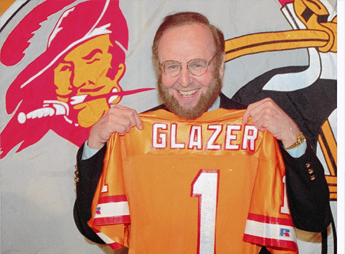
Early Life
Glazer was born in Rochester, New York, the fifth of seven children of Lithuanian Jewish immigrants, Abraham and Hannah Glazer. In 1943, he inherited his father's wholesale jewelry and watch repair business. He briefly attended Sampson College in Romulus, New York before committing himself full-time to jewelry and watch repair.
Business History
He won the concession at the Sampson Air Force Base. In 1956, after the base closed, he expanded into real estate investing in single-family homes, duplexes, and commercial buildings in Rochester, eventually specializing in the ownership and management of mobile-home parks, mainly in Florida. In 1963, he bought the National Bank of Savannah in upstate New York. In 1973, he bought the first of five nursing homes he was to own, the West Hill Convalescent Center in Hartford, Connecticut. In 1976, he purchased three television stations for $20 million including WRBL in Columbus, Georgia. In 1984, he founded First Allied Corporation, a holding company for his various endeavors where he served as president and chief executive officer. First Allied has invested in a diverse portfolio of international holdings and public companies including: First Allied, Zapata Corporation, Houlihan's Restaurant chain, Harley-Davidson, Formica, Tonka, Specialty Equipment and Omega Protein.
Glazer’s first attempt at a corporate takeover was in 1984, when he launched an unsuccessful $7.6 billion bid to buy the government controlled freight rail company, Conrail. He also failed in an attempted takeover of kitchen designer Formica in 1988 and, later, with motorcycle manufacturer Harley-Davidson. One of the companies that Glazer did purchase successfully was the nearly bankrupt Zapata Offshore, a remnant of Zapata Corporation, an oil and gas company founded by George H. W. Bush, which was left over after the latter's takeover by South Penn Oil to create Pennzoil. Glazer successfully diversified it into fish protein and Caribbean supermarkets.
Glazer owned a diverse portfolio of nationwide investments, which include food service equipment, food packaging and food supplies, marine protein, broadcasting, health care, property, banking, natural gas and oil, the Internet, stocks and bonds.
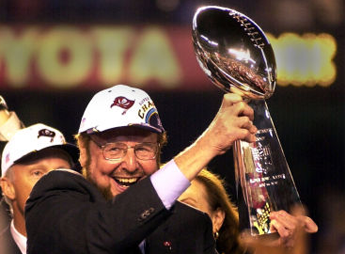
Sports Ownership
Tampa Bay Buccaneers
Glazer purchased the Tampa Bay Buccaneers franchise on January 16, 1995, following the death of former owner Hugh Culverhouse. Glazer served as president of the team, while sons Bryan, Joel and Edward are co-chairmen.
Since coming under the Glazer family’s ownership, the club has experienced an upswing in its fortunes, winning 131 regular season games, earning seven playoff berths and capturing its first Super Bowl Championship in Super Bowl XXXVII. Prior to Glazer’s purchase, the Buccaneers had won just 87 games in 19 seasons and had advanced to the postseason just three times.
Tampa Bay also eclipsed the club record for wins in a regular season with 12 in 2002. The top five single-season win totals in club history (12 in 2002, 11 in 2005, 11 in 1999, 10 in 2010, 10 in 2000 and 10 in 1997. The team also won 10 games in 1979) have all come under Glazer’s stewardship, and Tampa Bay was the only team in the league to play in the postseason each year from 1999 to 2002. The 2007 campaign saw the Buccaneers claim their third NFC South Division title in six years, the sixth division crown in franchise history.
In January 2009, Glazer and his family hired Raheem Morris as head coach of the Buccaneers, making him the youngest head coach in the National Football League upon his appointment. In addition, the family named longtime Director of Pro Personnel Mark Dominik as the fourth general manager in club history.
On January 27, 2012, Glazer and his family hired long-time Rutgers University head coach Greg Schiano as the ninth head coach in franchise history.
Glazer devoted a significant amount of time working to make the organization more fan-friendly by greatly increasing fan activities at Buccaneers home games through the expansion of the club’s community relations and special events departments. His mandate to enhance the team’s visibility in the community was reflected through increased appearances by Buccaneer players,coaches, cheerleaders and front office officials in recent years. Since 1999, the team has also coordinated with the Glazer Family Foundation to host "Gameday for Kids", a program that has hosted over 13,000 underprivileged youth at Buccaneers home games, giving them an opportunity to spend pre-game moments on the playing field and to cheer on the Buccaneers from exclusive seats in Raymond James Stadium.
Manchester United
Manchester United is one of the most popular and profitable football clubs in the world. Glazer acquired ownership of United in a £790m takeover by gradually buying out United shareholders between 2003 and 2005. Glazer's takeover was protested by a portion of United's fans due to financial concerns. Reportedly, Glazer had "effectively completed the takeover with the club's own cash", with United being £525m in debt after the takeover. This turned United from the richest club in the world to the one which owed the most money. However, Glazer's stroke in April 2006 resulted in his sons Joel and Avram, taking over the day-to-day running of the club, and Glazer's family continued to control the club through his death in 2014. Reportedly, Glazer had never stepped foot in the club's stadium, Old Trafford. The 2005–06 Manchester United F.C. season ended with United only winning the League Cup. Despite Glazer's death, his family owned a 90% stake in the club that is equally split among Glazer's six children.
Philanthropy
In addition to his business ventures, Glazer was also involved in philanthropic efforts. He launched the Glazer Family Foundation in 1999, which is dedicated to assisting charitable and educational causes in the Tampa Bay community. During its existence, the foundation has donated millions in programs, tickets, grants and in-kind contributions. The foundation donated $5 million toward the construction of the Glazer Children's Museum in downtown Tampa, which opened on September 25, 2010.
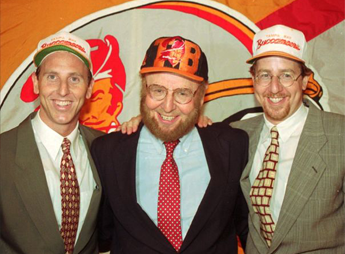
Glazer also oversaw the operations of the far-reaching Glazer Family Foundation’s Vision Program, created in 2006 to provide school-children with an opportunity to have vision problems identified in schools at an early age. The initiative, highlighted by the Vision Mobile, visits schools and provides eye examinations to thousands of disadvantaged children.
Glazer’s charitable activities also included the Tampa Bay Sports Commission, an organization that promotes amateur sports activities. Glazer committed $2 million to the Commission.
Personal life
Malcolm Glazer was married to Linda Glazer from 1961 until his death in 2014. They lived in Palm Beach, Florida, and had five sons and one daughter:
-
Avram Glazer, Co-Chairman of Manchester United.
Kevin E. Glazer
Bryan Glazer, vice-president at First Allied Corporation and Co-Chairman of the Tampa Bay Buccaneers.
Joel Glazer, vice-president at First Allied and Co-Chairman of the Tampa Bay Buccaneers and Manchester United.
Darcie S. Glazer Kassewitz, Co-President of the Glazer Family Foundation.
Edward S. Glazer, Director of Manchester United, Co-Chairman of the Tampa Bay Buccaneers, Co-Chairman of First Allied Corporation, Chairman and Owner of US Property Trust, Co-President of The Glazer Family Foundation.
The Glazers attended the Palm Beach synagogue in Palm Beach, Florida.
Passing
Glazer passed aged 85 on May 28, 2014, as announced by his team, the Tampa Bay Buccaneers. Glazer had been in poor health since suffering two strokes in April 2006.
Current Ownership - Glazer Family Foundation
Bryan Glazer - Co-Chairman
Co-Chairman Bryan Glazer enters his 22nd year with the Buccaneers, working tirelessly to support the Buccaneers franchise and brand. Possessing an acute business sense, Glazer, who oversees many of the day-to-day operations of the club, has shaped the Buccaneers into one of the most recognizable and successful franchises in the National Football League and has become a leader in the Bay Area, recognized for his tremendous community work.
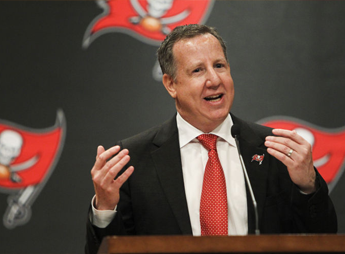
The Buccaneers have posted 154 regular season wins and five playoff wins with seven playoff appearances under Glazer’s leadership. That unprecedented level of success paints a stark contrast to the meager .300 winning percentage posted by the team prior to Glazer family ownership and included advancement to the postseason just three times from 1976-94.
Glazer and his entire family were on hand as Tampa Bay claimed its first NFL title with a 48-21 victory over Oakland in Super Bowl XXXVII on January 26, 2003, in San Diego. The Buccaneers, who were making their first appearance in the NFL’s championship game, also claimed the first-ever NFC South title in 2002, then the fourth division crown in team history. Tampa Bay also took NFC South titles in 2005 and 2007.
An instrumental figure in his family’s purchase of the Buccaneers in 1995, Glazer has been a driving force in improving every aspect of the club’s influence, both nationally and in the Tampa Bay region.
Glazer’s dedication to the Bay Area was also highlighted by his leadership in the construction of Raymond James Stadium, which successfully hosted both Super Bowl XXXV in 2001 and Super Bowl XLIII in 2009. Glazer played an integral role in helping to lure the 2009 game to the Bay Area, speaking to NFL owners on behalf of the team and the Tampa Bay community at the NFL League meetings in May 2005. Glazer is committed to continuing to bring future Super Bowls to the area.
Glazer’s innovative approach to business and penchant for thinking outside the box has resulted in many new developments for the club, including the creation of the Pewter Partners program, which rewards the Buccaneers’ sponsors with superior advertising packages and unprecedented customer service.
In addition to his business achievements, Glazer also has been involved in a number of vital football-related efforts directly associated to the on-the-field success experienced by the Buccaneers, certainly including, but not limited to, the team’s first Super Bowl championship.
A native of Rochester, New York, Glazer serves on the NFL’s Digital Media Committee, as appointed by NFL Commissioner Roger Goodell, and he makes regular community and charitable appearances on behalf of the Glazer Family Foundation, which was honored as Foundation of the Year by the Tampa Bay Sports Commission in 2011.
The Glazer Children’s Museum opened in Tampa in 2010, in large part due to the Foundation’s gift of $5 million. In addition to serving on the museum’s Board of Directors, Glazer is also a member of the Moffitt Cancer Center National Board of Advisors, The Board of Directors Advisory Council for Ronald McDonald House, the advisory board for the Outback Bowl, and, in the spring of 2011, he served as Chairman of the American Heart Association’s annual Heart Ball.
Glazer’s efforts to remain connected and active in the Bay Area community continued in 2015 with his $4 million dollar gift to jump start the development of a new state-of-the-art Jewish Community Center that is scheduled to open in West Tampa this year. The facility will be named the Bryan Glazer Family JCC and will serve an important role in the revitalization of the surrounding area, providing a place for families and community to come together.
In the spring of 2016, Glazer was honored with induction into the Tampa Bay Business Hall of Fame in recognition of his busines achievements and community leadership in and around the Tampa Bay region.
Glazer also serves on the Board of Manchester United, which has captured five Premier League titles (2007, 2008, 2009, 2011 and 2013), as well as the 2008 Champions League title during his tenure.
Glazer earned his bachelor’s degree in broadcast communications from American University in 1986, prior to completing his law degree from Whittier College School of Law in 1989. He resides in Tampa with his wife Shanna.
Darcie Glazer Kassewitz - Co-President
Darcie Glazer Kassewitz, Co-President of the Glazer Family Foundation, has worked tirelessly during her family’s ownership of the team to ensure that the Tampa Bay Buccaneers’ value to the community extends well beyond the playing field. Kassewitz has been the driving force behind the Buccaneers and the Foundation’s forward-thinking community outreach efforts and ensures that the core mission of making a difference in the lives of Tampa Bay area residents is carried out.
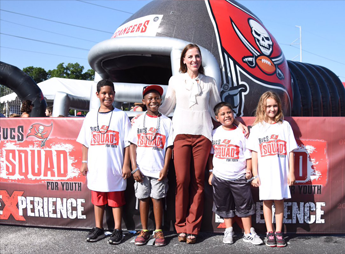
In August of 2015, Kassewitz introduced the Women of RED – an innovative fan engagement program focused on enhancing and improving the fan experience. In its highly-anticipated debut season, Women of RED was called “the tipping point for a genuine connection to fans”, attracting thousands of women to major events that offered a wide variety of interactive experiences, exclusive behind-the-scenes access, and the opportunity to interact with former Buccaneers legends and current executives.
Through a lead gift, the Glazer Family Foundation is proud to have brought the world-class Glazer Children’s Museum to Tampa as part of its ongoing dedication to children and families. A new way for children to become lifelong learners and leaders, the Children’s Museum opened on September 25th, 2010. This one-of-a-kind museum instantly became the featured destination for children and families in Tampa Bay, providing 53,000-square feet of space for safe and playful learning.
A commitment to education plays a central role to the Glazer Family Foundation’s core mission and in the fall of 2013, Kassewitz launched the Buccaneers Academies. Serving over 14,000 youth and 2,000 teachers in Hillsborough County, these 24 schools are provided with support from Buccaneers players, cheerleaders and staff including incentive-based programs and monthly challenges that offer engaging, and motivating opportunities to learn. Each Buccaneers Academy also receives a Buccaneers-themed Fitness Zone with a covered court to promote active and safe outdoor play. Additionally, upon completion of fifth grade, every Buccaneers Academies graduating student receives a Ticket to the Future, the commitment from the Buccaneers to grant students a job interview upon their graduation from college.
Kassewitz has also been the driving force behind the Glazer Family Foundation’s highly successful Vision Program, founded in 2006 to provide schoolchildren with an opportunity to have vision problems identified in school at an early age. To date, the Foundation has donated vision screening equipment to eight counties in West Central Florida. The Vision Mobile, a fun, interactive mobile eye clinic spearheaded by Kassewitz in 2009, provides the final step in vision services to correct students’ inability to see clearly by providing free eye exams and prescription eyeglasses to children at Title One schools. Since 2009, the Vision Mobile has conducted more than 65,000 eye screenings, performed 11,000 eye exams and provided more than 9,000 pairs of eye glasses to disadvantaged children. In October of 2015, Kassewitz and Pro Bowl defensive tackle Gerald McCoy unveiled a brand new Buccaneers-themed Vision Mobile, a customized RV that includes a rebranded exterior with engaging, interactive, kid-friendly features.
As part of the Buccaneers’ support of Breast Cancer awareness, Kassewitz hosts the annual Treasure Chests 5K Run/Walk & Corporate Challenge, which has evolved into one of the premier events of its kind in the Tampa Bay region. The Buccaneers welcomed more than 4,300 participants to the most recent race, and since 2013, has topped $100,000 in donations towards breast cancer awareness and patient services benefitting the American Cancer Society, Florida Cancer Specialists Foundation, the Florida Hospital Foundation and Moffitt Cancer Center.
To start every home Tampa Bay Buccaneers game, Kassewitz meets with children from local community groups on the field prior to kickoff as part of the Foundation’s Gameday For Kids program. To date, the Foundation has hosted more than 16,000 youth from organizations throughout the Bay area at Raymond James Stadium. Participating students are rewarded for academic achievement and positive behavior with complimentary game tickets, food vouchers and battle flags.
On the football side, Kassewitz has used her creative expertise to help shape the Buccaneers’ world-class facilities. Kassewitz set out to design a football stadium deemed worthy of a first-class organization, thereby creating a winning environment and revolutionizing fan experience and comfort. She ultimately shaped every detail of the interior of Raymond James Stadium, including the design of the expansive club levels, luxury suites and the Lower Galley restaurant. A massive undertaking, the stadium opened on time and budget to rave reviews, earning nods as the “Crown Jewel of the NFL.”
Tampa Bay’s training facility, which opened to high praise from across the National Football League in August 2006, is a technological marvel and sets a new standard of excellence for training facilities in the NFL. Kassewitz oversaw the entire interior design process for the team’s 136,320 square-foot state-of-the-art training facility, which encompasses the daily functions for all of the Buccaneers’ football and business operations.
One of the signatures of the training facility is the Tampa Bay Buccaneers Museum, which was designed and produced by Kassewitz. The museum brings the Buccaneers’ history to life, including in-depth exhibits that tell the story of the franchise. Featured displays explore the creation of the team’s uniform and logo, a description of Buccaneers head coaches since the team’s inception in 1976, and the organization’s move to Raymond James Stadium and One Buccaneer Place. Additional exhibits explain the history of the Tampa Bay Buccaneers Cheerleaders, the establishment of the Glazer Family Foundation, and the continual efforts by Buccaneers players to make an impact in the community. Included are features dedicated to the Buccaneers’ Super Bowl victory, including special exhibits showcasing the Lombardi Trophy and Super Bowl ring earned in Super Bowl XXXVII.
The lobby also includes the spectacular Moment of Victory sculpture exhibit, which depicts the moment when the Buccaneers were assured of their first World Championship and commemorates Tampa Bay’s victory over the Oakland Raiders in Super Bowl XXVII. Kassewitz not only came up with the concept for the sculptures, but oversaw the design and creation of this one-of-a-kind exhibit.
In addition to her responsibilities with the Glazer Family Foundation, she has served as Co-Chairwoman of the Make-A-Wish Foundation in Palm Beach. Kassewitz also serves on the Board of Manchester United Soccer Club, which has captured six titles since the Glazer family took over the club: five Premier League titles (2007, 2008, 2009 and 2011 and 2013), as well as the 2008 Champions League title.
Kassewitz graduated cum laude with a Bachelor of Science in Psychology from American University in 1990. She earned her Juris Doctorate from Suffolk Law School in 1993 and is a member of the New York State Bar Association. Kassewitz and her husband, Joel, reside in Tampa.
Edward Glazer - Co-Chairman
Entering his 22nd season with Tampa Bay in 2016, Co-Chairman Edward Glazer oversees many aspects of the team’s day-to-day business operations.
Recognizing that the fans are of the utmost importance to the team’s success, Glazer sets the tone for Tampa Bay’s commitment to its fan base. In recent years, Glazer has overseen a complete overhaul of the team’s marketing and sales departments, including the launch of a new Member Relations Department created exclusively for Buccaneers Season Pass Members. The department, which offers an array of off-the-field benefits and unparalleled customer service, has been a huge success as JD Powers ranked the Buccaneers No. 1 in customer satisfaction among all NFL teams for three out of the past four seasons.
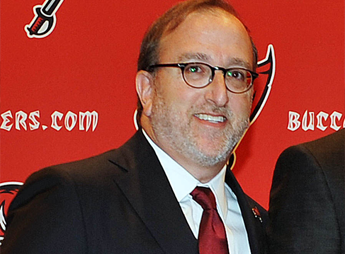
Glazer scrutinizes every detail of the business operations at One Buccaneer Place to ensure that fans are getting the best possible Buccaneers experience and value. In an effort to make season pass membership even more accessible to fans, Glazer introduced the NFL’s first 12-month interest-free payment plan.
With a focus on continually improving the gameday experience for Buccaneers fans, Glazer was instrumental in the renovation of Raymond James Stadium. The renovation is expected to exceed $140 million and will be completed in two phases. The first stage will be completed for the Buccaneers’ 2016 season and is highlighted by the installation of new, state-of-the-art HD video boards in each end zone, all new ribbon boards and four HD tower video displays in each corner of the lower bowl. Starting this season, Raymond James Stadium’s nearly 29,000 square feet of video display space will rank third largest among NFL venues. Also included will be the new surround sound system, a complete renovation of all luxury suites and the introduction of the exclusive all new, all-inclusive Hall of Fame Club.
Glazer worked closely with Nike and the NFL to create a bold, new look for the team’s new uniforms that were unveiled prior to the 2014 season. The enhanced logo – which features an enlarged flag and more menacing skull design – honors the Buccaneers’ rich tradition while boldly bringing the team into the future through a modern industrial aesthetic. The new uniform features a bold look with custom name and number fonts as well as the first chrome facemasks on an NFL helmet. The team also energized its color scheme with a richer shade of pewter juxtaposed with a brighter, more vibrant shade of red, as well as more prominently featuring “Bay Orange” as a primary trim and accent color.
The Glazer family has been devoted to building a winning team from their earliest days as owners. Under the Glazers, Tampa Bay has enjoyed its most successful stretch as a franchise, posting seven playoff appearances with four division championships in addition to a world championship in Super Bowl XXXVII, a 48-21 victory over the Oakland Raiders in San Diego on January 26, 2003.
With another Super Bowl victory as the ultimate goal, the Glazers have made bold, educated moves to assemble a winning franchise. In 2014, Glazer and his siblings hired General Manager Jason Licht and in 2016 they promoted offensive coordinator Dirk Koetter to head coach. The Buccaneers have drafted key pieces of the future while extending contracts for homegrown talent and securing important free agents. In 2015, the team’s draft produced an astonishing four rookies who made immediate impacts as starters: quarterback Jameis Winston, offensive linemen Donovan Smith and Ali Marpet, and linebacker Kwon Alexander. The team has also extended contracts for defensive tackle Gerald McCoy (2014), linebacker Lavonte David (2015) and running back Doug Martin (2016), ensuring that the vital core of the team’s foundation for future success stays intact.
In 2009, the Glazer family was honored with the prestigious Gonzmart Family Ambassador of the Year Award, as part of the 26th annual National Tourism Week, presented by Tampa Bay & Company. The Ambassador Award was presented to the Glazers in recognition of their efforts to help the tourism industry in the Bay Area, as well as their impact on the community overall.
In 2010, The Glazer Children’s Museum opened in downtown Tampa to rave reviews, earning recognition by Women’s Day Magazine as one of the Top 10 family museums in the country. For its wide-reaching efforts, the Tampa Bay Sports Commission named the Glazer Family Foundation the Foundation of the Year at the inaugural Sneaker Soiree in 2011.
Away from the football field, Glazer is also heavily involved in charitable endeavors. He is Co-President of the Glazer Family Foundation and helps oversee Foundation programs that provide incredible opportunities to Bay Area residents. The Foundation has donated millions in programs, tickets, grants and in-kind contributions.
Glazer and his wife, Shari, are committed to providing aid and assistance in the community, supporting many causes, including the Zimmer Children’s Museum, Cedars-Sinai Hospital, and the UCLA Mattel Children’s Hospital where the Ed and Shari Glazer unveiled the “B.F.F Bear Program” which gives free teddy bears to pediatric patients.
In addition to his duties with the Buccaneers, Glazer serves on the board of the family-owned Manchester United Soccer Club – the world’s most popular team with over 660 million fans worldwide. Under the Glazers’ ownership, the club has won the Premier League title in five of the last 10 seasons and has also played in three Champions League final matches, winning the 2008 Champions League title. In 2016, Manchester United took home the FA Cup. Glazer is also Co-Chairman of First Allied Corporation and Owner and C.E.O. of US Property Trust.
A proud Ithaca College alumnus, Glazer recently opened the Edward and Shari Glazer Arena on the school’s campus. Glazer and his wife Shari have three daughters.
Joel Glazer - Co-Chairman
The fast-paced and ultra-competitive environment that characterizes the National Football League is a perfect match for Joel Glazer’s business acumen. These attributes have proven integral to the Buccaneers’ transformation into one of the most successful franchises in the league.
Now in his 22nd season with the Buccaneers, Co-Chairman Joel Glazer, along with his brothers Bryan and Edward, oversees the day-to-day operations of the franchise, ensuring the club achieves and maintains the highest levels of success in all aspects.
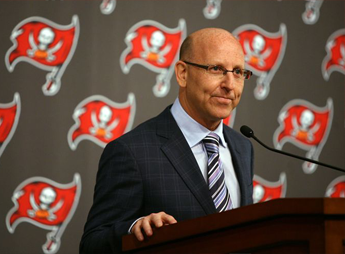
The family’s leadership and dedication to the team is evidenced by the Buccaneers’ seven playoff berths and first-ever Super Bowl Championship – all of which have come under Glazer ownership. That unprecedented level of success paints a stark contrast to the meager .300 winning percentage posted by the team prior to its purchase by the Glazer family.
As Co-Chairman, Glazer’s keen insight and tireless dedication continue to enhance the reputation of the Buccaneers. Glazer has passionately spearheaded a number of vital efforts throughout the years that have not only helped shape the club into a contender, but a model NFL franchise as well.
Glazer had a single vision, shared by all members of the Glazer family when they acquired the Tampa Bay Buccaneers in 1995: build a franchise from the ground up, one that would become one of the most respected and successful in the NFL. That vision was realized when Tampa Bay claimed its first NFL title with a 48-21 victory over Oakland in Super Bowl XXXVII on January 26, 2003, in San Diego. The Buccaneers, who were making their first appearance in the NFL’s championship game, also claimed their first-ever NFC South title in 2002, then the fourth division crown in team history. Tampa Bay also took the NFC South in 2005 and 2007.
Glazer, promising a world-class facility, led the design development for the club’s 136,320 square-foot state-of-the-art team headquarters which opened to rave reviews in August 2006. Located mere blocks from Raymond James Stadium, One Buccaneer Place is one of the finest training facilities in the National Football League. The signature of the site is its breathtaking entrance, which features the world’s largest football, towering nearly five stories tall.
After the family’s acquisition of the Buccaneers in 1995, Glazer began the day-to-day duties of overseeing all aspects of the organization. Since assuming his current role with the club, the Buccaneers have recorded 154 regular-season wins and five playoff wins. Tampa Bay reached the playoffs for the fourth consecutive time in 2002, the only team in the league to head to the postseason all four years from 1999-2002. In addition, the Buccaneers’ have seen seven playoff appearances since 1997. Prior to the Glazers’ arrival, the franchise advanced to the postseason just three times in the previous 19 years, from 1976-94.
Since his arrival in Tampa, Glazer has directed his attention on vital elements of building a successful franchise, namely the front office and stadium. After completely reorganizing the front office and recruiting talented people from a variety of backgrounds, he worked tirelessly alongside his brother, Bryan, to build a community consensus for local approval of what would become Raymond James Stadium. The Glazers set out to design a stadium deemed worthy of a first-class organization, thereby creating a winning environment and revolutionizing fan experience and comfort. They visited approximately 25 different stadiums, drew from their experiences as fans, and ultimately shaped every detail of RJS.
A massive undertaking, the stadium opened on time and budget, earning nods as the “Crown Jewel of the NFL.” The signature element – Buccaneer Cove – features a 103-foot replica pirate ship that fires cannons to celebrate Buccaneers touchdowns. Upon its opening, Raymond James Stadium featured amenities never seen before in modern stadiums, and it continues to provide an exciting, innovative gameday experience to this day.
With the support of Glazer and his brothers, the Buccaneers reached an agreement in the fall of 2015 with the Tampa Sports Authority that will result in a comprehensive renovation of Raymond James Stadium. The multi-stage renovation plan is expected to exceed $140 million and will be completed in two phases. The first stage is scheduled to be completed for the Buccaneers’ 2016 season and is highlighted by the installation of new, state-of-the-art HD video boards in each end zone and four HD tower video displays in each corner of the lower bowl, giving the stadium a total video display area of 28,416 feet – the third-largest in the NFL. Also included will be a new, comprehensive sound system and the renovation of all luxury suites. The project helps to ensure that Raymond James Stadium remains one of the top stadium destinations in the NFL.
Throughout the construction of Raymond James Stadium, Glazer created the sales and marketing efforts that led to record season ticket club seat, luxury suite and group sales. In addition to helping create the club’s prestigious corporate Pewter Partners sponsorship program, Glazer’s other duties include overseeing the organization’s annual budgets and establishing the club’s strategic planning in marketing, community relations, public relations, ticketing and luxury suite relations.
In March of 2014, the Glazers unveiled exciting changes to the franchise, introducing an updated logo, color scheme and uniform design, which were the result of several years of development and collaboration with Nike and NFL Properties. The enhanced logo – which features an enlarged flag and more menacing skull design – honors the Buccaneers’ rich tradition while boldly bringing the team into the future through a modern industrial aesthetic. Along with chrome facemasks on the helmet, the new uniform features a bold look with custom name and number fonts. The team’s colors were also energized with a richer shade of pewter juxtaposed with a brighter, more vibrant shade of red, as well as more prominently featuring “Bay Orange” as a primary trim and accent color.
Glazer represents the team at all NFL Owners Meetings, addressing the media with a “state of the franchise” address. He played an integral role at the 2005 Spring Meetings to help Tampa Bay land the 2009 Super Bowl. The Bay Area won the bid for Super Bowl XLIII, marking the fourth Super Bowl for Tampa Bay.
Glazer has been very active in the Tampa Bay community through the Glazer Family Foundation, which is dedicated to helping children in the Bay area through charity initiatives. The Foundation donated $5 million toward the construction of a new children’s museum, the Glazer Children’s Museum, in downtown Tampa, which opened in 2010 and was recently named one of the Top Ten Family Museums in the country by Women’s Day Magazine. For its wide-reaching charitable efforts, The Tampa Bay Sports Commission named the Glazer Family Foundation the Foundation of the Year at the inaugural Sneaker Soiree held in 2011. In addition to his community efforts, Glazer has been an active member of the Super Bowl Task Force, Tampa Chamber of Commerce Board of Directors and the Outback Bowl Advisory Committee. Glazer currently sits on the NFL International, NFL Finance and NFL Stadium committees.In 2009, the Glazer family was honored with the prestigious Gonzmart Family Ambassador of the Year Award, as part of the 26th annual National Tourism Week, presented by Tampa Bay & Company. The Ambassador Award was presented to the Glazers in recognition of their efforts to help the tourism industry in the Bay Area, as well as their impact on the community overall.
Glazer also serves as Co-Chairman of Manchester United, which has captured five Premier League titles (2007, 2008, 2009, 2011 and 2013) as well as the 2008 Champions League title during his tenure. His work with the club led to his naming as one of the Top 10 most influential Americans in the United Kingdom by The Telegraph.
Glazer earned his bachelor’s degree in interdisciplinary studies from American University in 1989. The Rochester, New York native is married to Angela, and the couple has two children.

